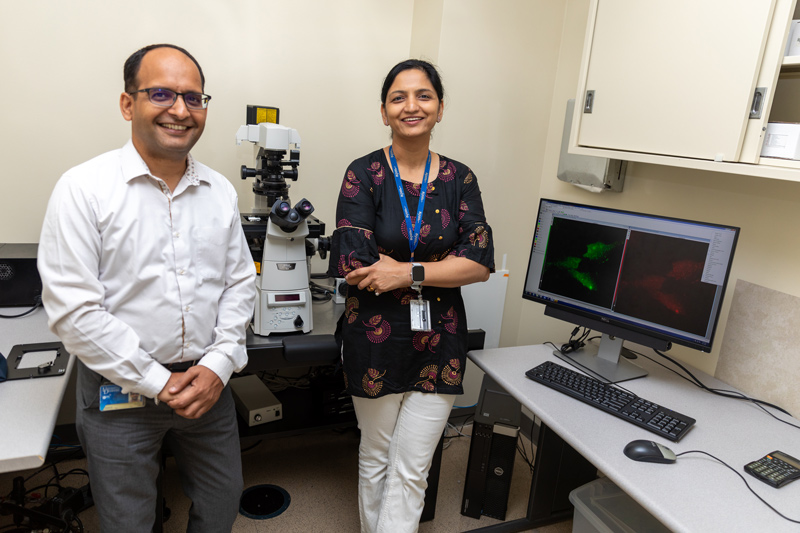


How cells communicate
Photo by Ashley Barnas August 21, 2023
UD molecular biologist, colleagues receive NSF grant to enhance understanding of cellular communication
For a long time, extracellular vesicles (EVs) were often thought of as garbage bags containing a myriad of materials that cells don’t need.
But scientists have since learned that EVs are instrumental in various biological activities from homeostasis and cell-cell communication to cancer progression. University of Delaware molecular biologist Mona Batish likened them to FedEx envelopes.
“They’re addressed envelopes containing handpicked materials with specific addresses they go to; this is a way cells talk to one another,” Batish said. “For example, if a cell got infected with a virus, it would release material into EVs, which will be taken up by neighboring cells, so they’re prepared when the virus reaches them.”
Cancer can hijack the process of packaging EVs.
“It starts sending material into the packages and tells the immune response, ‘Nothing is wrong,’” Batish said. “That’s how cancer silently grows until a tumor becomes so big the body cannot do anything about it.”
EVs carry a range of cargo, including proteins, lipids, and nucleic acids like DNA and RNA.
Past research has focused on understanding the synthesis and release of the EVs from the cell, but little is known about how RNA cargo is sorted, packaged, and transported into EVs. Batish has been awarded a $1 million grant from the National Science Foundation to study the mechanism of RNA sorting, packaging, and transport into EVs. Vijay Parashar, assistant professor of medical and molecular sciences, and Shawn Polson, associate professor of computer and information sciences and director of UD’s bioinformatics core facility, are co-investigators on the NSF grant.
“My interest is in examining RNAs in EVs because RNA packaged into an exosome can go into another cell and make a protein, and that protein can change the behavior of the recipient cell,” Batish said.
Batish, an associate professor in the Department of Medical and Molecular Sciences in the College of Health Sciences, is an expert in single-molecule imaging.
“The process of cell communication has never been explored on a single-molecule level,” Batish said. “Since we have the expertise to see every RNA molecule individually, we can tag it, track it, and follow how it gets into the EV to understand the transport process better.
“The use of this kind of single-molecule imaging will provide the first visual validation of sorting and delivery processes and will serve as the basis of future advancements in our understanding of cellular communication,” Batish said. “If we can understand the signature, the motif, and what’s required for a given RNA to be packed into an EV, we can help in developing EVs to selectively package engineered therapeutic RNAs on demand.”
Her findings, down the road, could have targeted therapeutic impacts, especially in cancer treatment.
“By putting engineered RNAs into an EV, we can target a single cancer cell,” Batish said. “This method would release the therapeutic RNA to cancer cells specifically and kill that cell only, thereby reducing the side effects on healthy cells.”
EV cargo also makes non-invasive diagnostics possible.
“For example, through a blood draw, we can find exosomes in the blood and look for RNA present in them,” Batish said. “If there’s a marker RNA linked to certain cancers, we could find cancer in the liver or brain through a simple blood test ahead of any invasive testing.”
Ahmed Abdelgawad, who’s obtaining his doctorate in medical sciences, has been working in Batish’s lab for years. He said he is fascinated by the potential therapeutic impacts of this research.
“We need to have a deeper understanding of the factors involved in RNA transport because it will help us in the future to use EVs to target specific cells and deliver RNAs to those cells for therapeutic purposes like gene therapy,” said Abdelgawad.
The interdisciplinary aspect of the research makes for a highly complementary team.
Polson will help analyze RNA sequencing datasets to identify common signatures.
“Often when my group analyzes RNA present in a sample, we don’t have any context for where the sequences are actually occurring,” Polson said. “An exciting aspect of this study will be the opportunity to take these sequence data and visually track their transport within EVs, allowing us to see where they are and where they are going, helping to clarify how they function in the biological big picture.”
Parashar will study the interactions of EV-bound RNAs with RNA-binding proteins.
“This is cutting-edge science dealing with how cells talk to each other via the extracellular vesicles,” Parashar said. “We know EVs exist and play a critical role; we just don’t know how they selectively sort and pick their content to execute different roles. We’ll work to determine what is special about the EV cargo, particularly RNAs, that get selected to be packaged into the EVs.”
He also stressed the therapeutic values of this research.
“Once we identify the mechanism of interaction of EV-bound RNA with RNA-binding proteins, we can utilize this knowledge to better understand both the inter- and intra-cellular RNA transport,” Parashar said.
After the sorting and packaging of cells are clearly defined, Batish and Parashar will seek to monitor RNA sorting, packaging, and transport under disease conditions.
“The long-term translational goals of this interdisciplinary team are to identify novel biomarkers packaged into EVs for non-invasive diagnosis and develop new tools for engineering EVs to efficiently deliver therapeutic RNAs,” Batish said. “Our work is fundamental and timely to accomplish the full translational potential of these intriguing tiny but mighty packages.”
Contact Us
Have a UDaily story idea?
Contact us at ocm@udel.edu
Members of the press
Contact us at 302-831-NEWS or visit the Media Relations website

